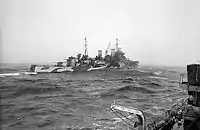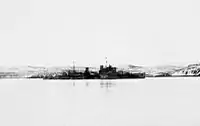HMS Trinidad (46)
HMS Trinidad was a Royal Navy Crown Colony-class cruiser (also known as the Fiji class). She was lost while serving in the Arctic on convoy duty after being damaged escorting PQ 13 in 1942.
 Trinidad in 1942 | |
| History | |
|---|---|
| Name: | HMS Trinidad |
| Namesake: | Trinidad |
| Builder: | HM Dockyard Devonport |
| Laid down: | 21 April 1938 |
| Launched: | 21 March 1941 |
| Commissioned: | 14 October 1941 |
| Fate: | Damaged in air attack and scuttled 15 May 1942 |
| General characteristics | |
| Class and type: | Crown Colony-class light cruiser |
| Displacement: | 8,000 tons |
| Length: | 169.3 m (555 ft) |
| Beam: | 18.9 m (62 ft) |
| Draught: | 5 m (16 ft) |
| Propulsion: |
Four oil fired 3-drum Admiralty-type boilers, 4-shaft geared turbines, 4 screws, 54.1 megawatts (72,500 shp) |
| Speed: | 33 kn (61 km/h) |
| Complement: | 907 |
| Armament: |
|
| Armour: |
|
| Aircraft carried: | Two Supermarine Walrus aircraft |
Early career

Trinidad was built by HM Dockyard Devonport. She was laid down on 21 April 1938, launched 21 March 1941 and commissioned on 14 October 1941. The ship served with the British Home Fleet during her brief career.
Loss
While escorting Convoy PQ 13 in March 1942, she and other escorts were in combat with German Narvik-class destroyers. She hit and damaged the German destroyer Z26 and then launched a torpedo attack. One of her torpedoes had a fault, possibly affected by the icy waters and sub zero conditions common in the Atlantic en-route to Russia; causing the torpedo to limp across the water at a speed far below the 46 knots expected, the reduced speed causing the torpedo to strike Trinidad as she performed evasive zigzags in its path, killing 32 men. Survivors included Lieutenant Commander Williams as well as composer George Lloyd, a Royal Marines bandsman who had earlier written the ship's official march. This was performed at the Last Night of the Proms on 7 September 2013, in the presence of the last surviving crewman from Trinidad.[1]
Trinidad was towed clear of the action, and was then able to proceed under her own power towards Murmansk. The German submarine U-378[2] attempted to engage and sink the damaged cruiser, but was spotted and attacked by the destroyer Fury.[3] On arrival in Murmansk, Trinidad underwent partial repairs.

She set out to return home on 13 May 1942, escorted by the destroyers Foresight, Forester, Somali and Matchless. Other ships of the Home Fleet were providing a covering force nearby. Her speed was reduced to 20 knots (37 km/h) owing to the damage she had sustained. En route, she was attacked by more than twenty Ju 88 bombers on 14 May 1942. All attacks missed, except for one bomb that struck near the previous damage, starting a serious fire. Sixty-three men were lost,[4] including twenty survivors from the cruiser Edinburgh, which had been sunk two weeks earlier. The decision was taken to scuttle her and on 15 May 1942 she was torpedoed by Matchless and sank in the Arctic Ocean, north of North Cape.[5] Four Czechoslovak airmen en route to Great Britain – Sergeant Vratislav Laštovička, Corporals Jan Ferák, Josef Návesník and Bohuslav Zikmund – were killed,[6] and three other airmen were rescued.
References
- "Proms night for HMS Trinidad Arctic Convoy veteran". BBC News. 7 September 2013. Retrieved 27 March 2015.
- "U-378". uboat.net. Retrieved 27 March 2015.
- "Russian Convoys 1941–45". naval-history.net. Retrieved 27 March 2015.
- "HMS Trinidad – Colony type light cruiser". naval-history.net. Retrieved 27 March 2015.
- "HMS Trinidad (46)". uboat.net. Retrieved 27 March 2015.
- "Při potopení HMS Trinidad zahynuli čtyři čs. letci 15. 5. 1942 - 77 let" [During the sinking of HMS Trinidad, four MS pilots died. 15. 5. 1942 - 77 years ago]. fronta.cz (in Czech). Retrieved 8 May 2020.
- Colledge, J. J.; Warlow, Ben (2006) [1969]. Ships of the Royal Navy: The Complete Record of all Fighting Ships of the Royal Navy (Rev. ed.). London: Chatham Publishing. ISBN 978-1-86176-281-8.
- Raven, Alan; Roberts, John (1980). British Cruisers of World War Two. Annapolis, MD: Naval Institute Press. ISBN 0-87021-922-7.
- Rohwer, Jürgen (2005). Chronology of the War at Sea 1939–1945: The Naval History of World War Two (Third Revised ed.). Annapolis, Maryland: Naval Institute Press. ISBN 1-59114-119-2.
- Whitley, M. J. (1995). Cruisers of World War Two: An International Encyclopedia. London: Cassell. ISBN 1-86019-874-0.
Further reading
- Pearce, Frank (1975). The Ship That Torpedoed Herself: HMS "Trinidad". ISBN 0-904593-02-9
External links
| Wikimedia Commons has media related to HMS Trinidad (46). |